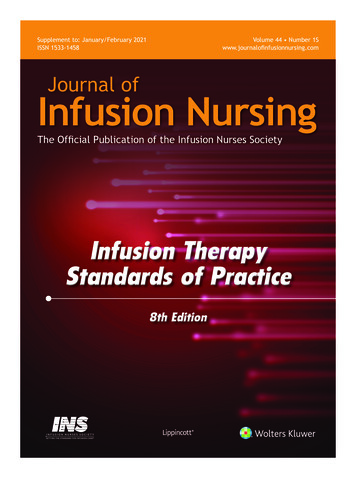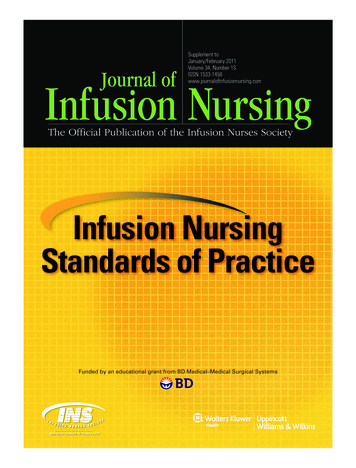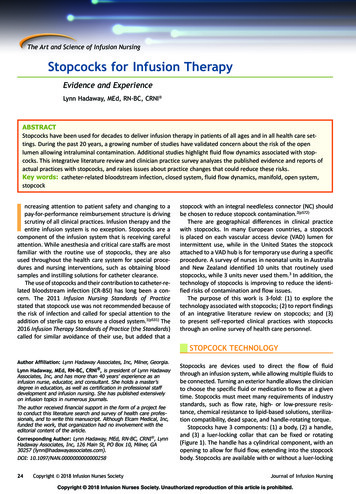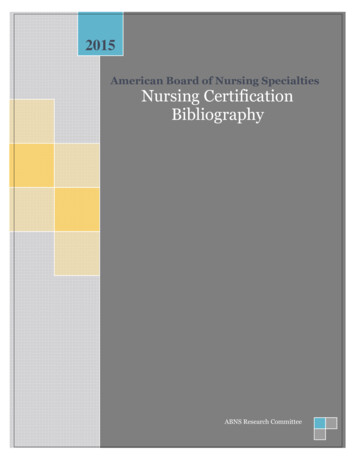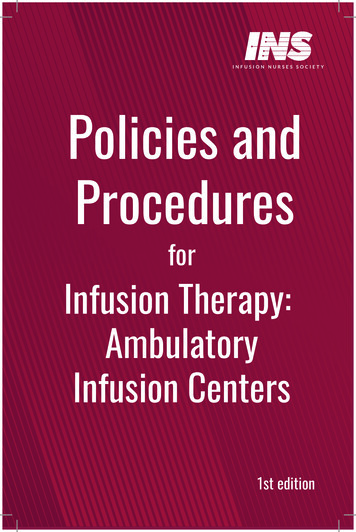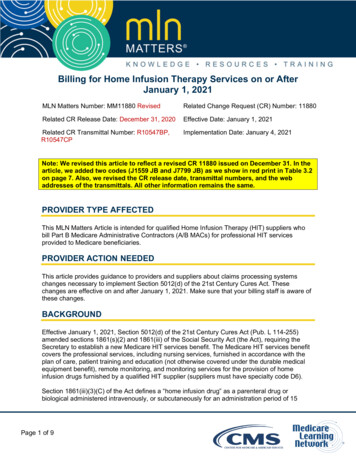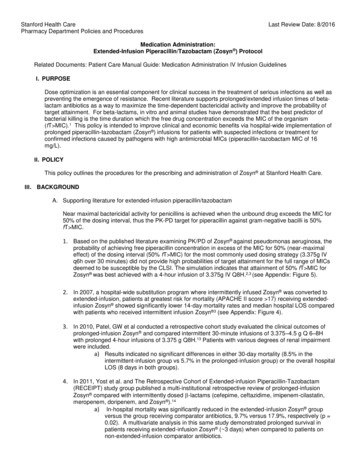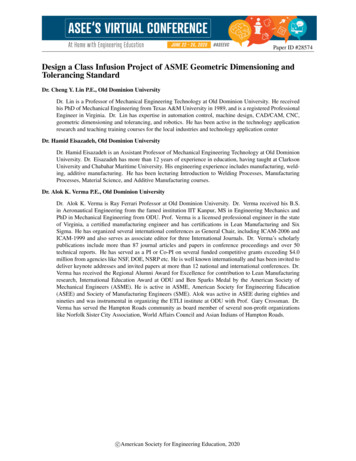
Transcription
Paper ID #28574Design a Class Infusion Project of ASME Geometric Dimensioning andTolerancing StandardDr. Cheng Y. Lin P.E., Old Dominion UniversityDr. Lin is a Professor of Mechanical Engineering Technology at Old Dominion University. He receivedhis PhD of Mechanical Engineering from Texas A&M University in 1989, and is a registered ProfessionalEngineer in Virginia. Dr. Lin has expertise in automation control, machine design, CAD/CAM, CNC,geometric dimensioning and tolerancing, and robotics. He has been active in the technology applicationresearch and teaching training courses for the local industries and technology application centerDr. Hamid Eisazadeh, Old Dominion UniversityDr. Hamid Eisazadeh is an Assistant Professor of Mechanical Engineering Technology at Old DominionUniversity. Dr. Eisazadeh has more than 12 years of experience in education, having taught at ClarksonUniversity and Chabahar Maritime University. His engineering experience includes manufacturing, welding, additive manufacturing. He has been lecturing Introduction to Welding Processes, ManufacturingProcesses, Material Science, and Additive Manufacturing courses.Dr. Alok K. Verma P.E., Old Dominion UniversityDr. Alok K. Verma is Ray Ferrari Professor at Old Dominion University. Dr. Verma received his B.S.in Aeronautical Engineering from the famed institution IIT Kanpur, MS in Engineering Mechanics andPhD in Mechanical Engineering from ODU. Prof. Verma is a licensed professional engineer in the stateof Virginia, a certified manufacturing engineer and has certifications in Lean Manufacturing and SixSigma. He has organized several international conferences as General Chair, including ICAM-2006 andICAM-1999 and also serves as associate editor for three International Journals. Dr. Verma’s scholarlypublications include more than 87 journal articles and papers in conference proceedings and over 50technical reports. He has served as a PI or Co-PI on several funded competitive grants exceeding 4.0million from agencies like NSF, DOE, NSRP etc. He is well known internationally and has been invited todeliver keynote addresses and invited papers at more than 12 national and international conferences. Dr.Verma has received the Regional Alumni Award for Excellence for contribution to Lean Manufacturingresearch, International Education Award at ODU and Ben Sparks Medal by the American Society ofMechanical Engineers (ASME). He is active in ASME, American Society for Engineering Education(ASEE) and Society of Manufacturing Engineers (SME). Alok was active in ASEE during eighties andnineties and was instrumental in organizing the ETLI institute at ODU with Prof. Gary Crossman. Dr.Verma has served the Hampton Roads community as board member of several non-profit organizationslike Norfolk Sister City Association, World Affairs Council and Asian Indians of Hampton Roads.c American Society for Engineering Education, 2020
Design a Class Infusion Project of ASME Geometric Dimensioning andTolerancing StandardAbstractThis paper describes the development of a short course of Geometric Dimensioning andtolerancing (GD&T) for Mechanical Engineering (ME)/Mechanical Engineering Technology (MET)students in their freshman/sophomore classes. This class-infusion project was assisted andvalidated by an ASME Standards and Certification Engineer and was jointly sponsored by theASME Committee on Engineering Education and the ASME Council on Standards andCertification. To assess the performance of the project, an instrument was developed withmultiple-choice problems and survey questions for the students. The results of a field test in asophomore manufacturing class are presented. The module is available at the ASME Dropboxand the developers are seeking other colleges to promote the project and participate in thefield test.1. IntroductionAfter surveying 2500 industry engineering supervisors, early career mechanical engineers andME Department Heads it was found that 46.9% of industry supervisors state a weakness inunderstanding of standards among ME/MET graduates and 48.3% of early career engineersstate their own weakness of standards understanding1. In addition, under the programcurriculum section in the self-study report requirements for both the Engineering AccreditationCommission (EAC) and Engineering Technology Accreditation Commission (ETAC), evidence of“incorporates appropriate engineering standards” must be documented 2,3. To help achieve thegoal of providing the knowledge of engineering standards to ME/MET students, ASMEassembled a team of standards experts and engineering faculty to collaboratively devise andtest an approach to infuse a selection of engineering standards into selected undergraduatecourse content - strategically spread through each of the typical four years4.As GD&T is commonly adopted in the design and manufacturing industries, this paper presentsa class infusion project involving this system. Because GD&T uses a symbolic language toimprove the communication for designers, manufacturers, and inspectors, a part’s function canbe fully and concisely described when using the standard correctly5. Many companies aremigrating their conventional drawings to GD&T drawings so having knowledge of this standardwill certainly enhance ME/MET students in their design capability and future careerdevelopment. Several papers have discussed teaching GD&T in engineering education6,7,8. Forthose colleges which do not offer the standard in their program curriculum, this projectbecomes even more important.In order not to disrupt a course’s schedule, the authors developed a series of short twenty-fiveminute PowerPoint presentations covering the following topics:
a.b.c.d.e.Traditional dimensions and tolerances.Types of traditional tolerances.An interesting example/problem of stacked tolerance.Inadequateness of traditional dimensions & tolerances.GD&T symbols and GD&T standards.To be able to present the class infusion in approximately twenty-five minutes, the paper startswith a short introduction of traditional dimensions and tolerances. Also, to raise students’interests in dimensioning and tolerancing, an example of stacked tolerance is introduced. A keydesign example is then given to explain the limits of only using traditional dimensioning andtolerancing, and the need of ASME GD&T Standards is finally introduced. A field test wasperformed in a class of introduction to manufacturing processes including a power pointpresentation, an assessment test, and a students’ opinion survey. Results of the test are providedand discussed.2. Traditional Dimensions and TolerancesThe presentations begin with the definition of dimensions (figure 1) followed by examples oftraditional size, location, and orientation dimensions (figure 2).Figure 1: Definition of Dimensions
Figure 2: Types of Traditional DimensionsThe next topic covered is the definition of a tolerance (figure 3) along with explaining thedifference between dimensions and tolerances (figure 4) taken from the fundamental rules ofASME Y14.5 20099. Figure 4 particularly indicates that the tolerance should include both atraditional tolerance and a geometric tolerance and explains that a minor error in dimensioningand tolerancing could lead to a significant financial loss in the final product10.Figure 3: Definition of a ToleranceFigure 4: Dimensions versus Tolerances3. Types of Traditional Tolerances
To be able to further discuss GD&T tolerances, it is important to make students aware of themany types of traditional tolerances10 available to use when dimensioning ang tolerancing.Figure 5 shows that traditional tolerances include limit tolerance, equal-bilateral tolerance,unilateral tolerance, and unequal-bilateral tolerance. The dimension “1.50” is called thenominal value10, this is the designation used for the purpose of general identification of adimension.Figure 5: Traditional Tolerances4. An interesting example/problem of stacked toleranceTo assist students with learning the proper use of tolerances in an engineering drawing, Figure6 provides a simple multiple-choice problem for tolerance calculations. Figure 7 presents thesolution of the problem. From this example, students will understand why the tolerance will be“stacked” for a dimension which is not specified in a drawing.Figure 6: Example for a Stacked-Tolerance Calculation
Figure 7: Solution of the Problem in Figure 65. Inadequateness of traditional dimensions & tolerancesTo attract students’ attention towards the benefits of GD&T, Figure 8 provides an example todemonstrate the inadequateness of traditional dimensioning and tolerancing when applied toan assembly between two concentric holes and a slender and long shaft. The shaft is designedto slide freely through the two holes A and B. In traditional dimensioning and tolerancing, adrawing only provides the sizes and tolerances of the holes and the shaft with the following twocritical pieces of information missing:a. Concentricity of the two holes.b. Straightness of the shaft.This example illustrates the need of GD&T knowledge in the design of mechanical assemblies.
Figure 8: Inadequateness of Traditional Dimensioning and Tolerancing6. GD&T Symbols and StandardFigure 9 defines GD&T and lists all geometric characteristic symbols. A very commonly seendrawing using position tolerance is also provided as a visual aid. Finally, Figure 10 presents thecurrent GD&T standard in the United States: ASME Y 14.5 - 2009Figure 9: GD&T Symbols
Figure 10: ASME Y14.5-20097. Field TestTo assess the performance of the project, an instrument was developed with multiple-choiceproblems. In addition, a survey consisting of four questions was conducted among thestudents: (1) This topic presents a clear description of traditional dimensions and tolerances, (2)Explanation of a stacked tolerance is clear, (3) The reasons of “why GD&T?” is clear, and (4)Definition of GD&T standards is clear. Figure 11 shows the performance-assessment problems.
Figure 11: Performance-Assessment ProblemsThe survey and performance-assessment test were given to students in a manufacturingprocess course. Figure 12 shows the results of the survey-questions and Figure 13 shows theresults of the class review test. Results of the survey are summarized below:a. 94% students agree or strongly agree that a clear description of traditional dimensionsand tolerances is well addressed.b. 94% students agree or strongly agree that the stacked tolerance is well addressed.c. 88% students agree or strongly agree that “why GD&T?” is clearly addressed.d. 100% students agree or strongly agree that definition of GD&T standard is clear.e. Students received an 84% test average in multiple choice problem assessment.This module is available at the ASME Dropbox and the developers are seeking other colleges topromote the project and participate the field test.
Figure 12: Survey-Question ResultsFigure 13: Performance-Assessment Results8. SummaryFrom this field test, students displayed a very positive response in the survey questions andperformed well in the assessment test. As observed from Question 3 in the survey, theyparticularly agree that the reasons of “why GD&T” is clear. This class-infusion project tookapproximately twenty-five minutes in total and therefore, it will not affect the progress of the
original class. This module is available at the ASME Dropbox and the developers are seekingother colleges to promote the project and participate the field test.Bibliography1.American Society of Mechanical Engineers, “Engineering Student . ABET, “2020-2021 Self-Study Templates”, riteria/selfstudy-templates/3. ABET, “Criteria for Accrediting Engineering Technology Programs, 2018 – ngtechnology-programs-2018-20194. Huderson, A., Lawrey, A., Perry, T., and Balkey, K., “Industry Standards Infusion throughout MechanicalEngineering and Mechanical Engineering Technology Degree Programs”, 2019 ASEE Annual Conference &Exposition, Tampa, Florida, June 20195. Engineers Edge, “What are the Advantages using Geometric Dimensioning and Tolerancing GD&T”,https://www.engineersedge.com/training documents/advantages geometric dimensioning tolerance.htm6. Rios, O., “An Example of Teaching Geometric Dimensioning and Tolerancing (GD&T) Concepts using 3DPrinted Parts”, 2018 ASEE Gulf-Southwest Section Annual Meeting, April 20197. Yip-Hoi, D., Gill, D., “Use of Model-Based Definition to Support Learning of GD&T in a ManufacturingEngineering Curriculum”, 2017 ASEE Annual Conference & Exposition, Columbus, Ohio, June 20178. Paige, M., Fu, K., “Spatial Demonstration Tools for Teaching Geometric Dimensioning and Tolerancing(GD&T) to First-Year Undergraduate Engineering Students”, 2017 ASEE Annual Conference & Exposition,Columbus, Ohio, June 20179. ASME Y 14.5 - 2009, “Dimensioning and Tolerancing”, The American Society of Mechanical Engineers,2009, ISBN 978079183192210. Krulikowski, A., “Fundamentals of Geometric Dimensioning and Tolerancing”, ALEX KRULIKOWSKI ANDEFFICETIVE TRAINING INC., 2012
Design a Class Infusion Project of ASME Geometric Dimensioning and Tolerancing Standard Dr. Cheng Y. Lin P.E., Old Dominion University Dr. Lin is a Professor of Mechanical Engineering Technology at Old Dominion University. He received his PhD of Mechanical Engineering from Texas A&a
